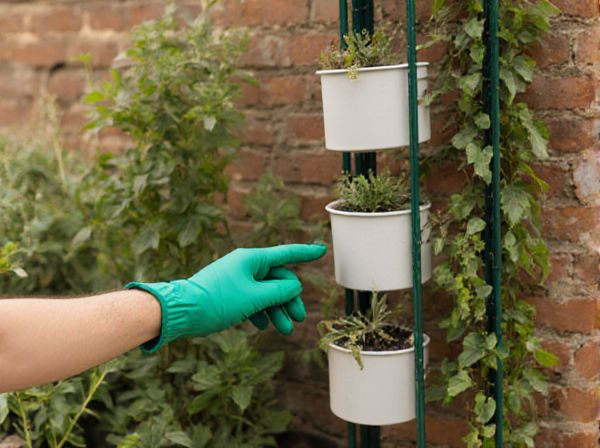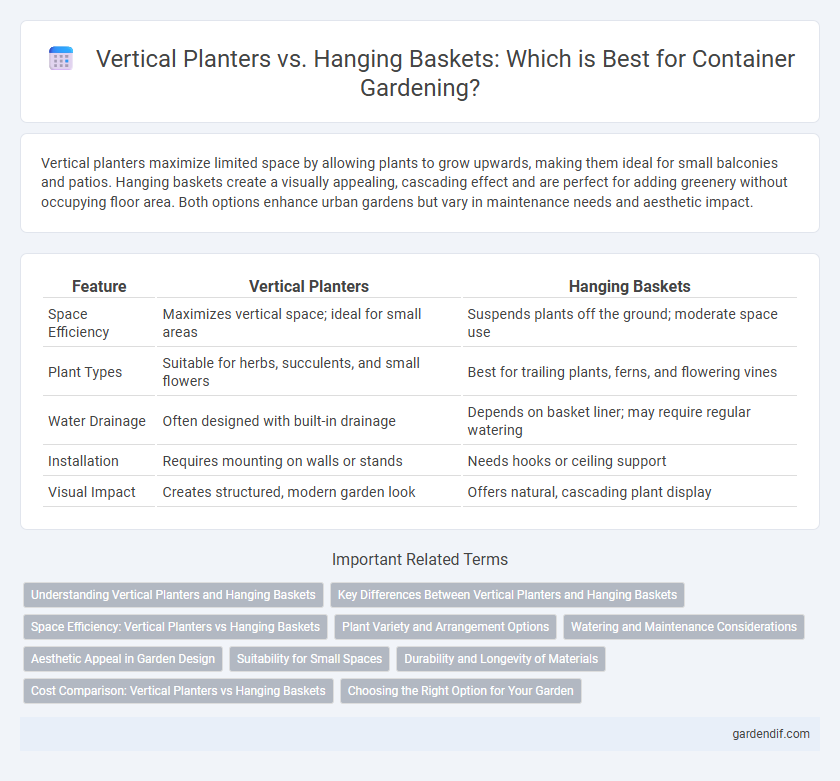
Vertical planters vs hanging baskets Illustration
Vertical planters maximize limited space by allowing plants to grow upwards, making them ideal for small balconies and patios. Hanging baskets create a visually appealing, cascading effect and are perfect for adding greenery without occupying floor area. Both options enhance urban gardens but vary in maintenance needs and aesthetic impact.
Table of Comparison
| Feature | Vertical Planters | Hanging Baskets |
|---|---|---|
| Space Efficiency | Maximizes vertical space; ideal for small areas | Suspends plants off the ground; moderate space use |
| Plant Types | Suitable for herbs, succulents, and small flowers | Best for trailing plants, ferns, and flowering vines |
| Water Drainage | Often designed with built-in drainage | Depends on basket liner; may require regular watering |
| Installation | Requires mounting on walls or stands | Needs hooks or ceiling support |
| Visual Impact | Creates structured, modern garden look | Offers natural, cascading plant display |
Understanding Vertical Planters and Hanging Baskets
Vertical planters maximize limited space by allowing multiple plants to grow upward on structures like walls or trellises, offering improved air circulation and ease of maintenance. Hanging baskets suspend plants in containers from hooks or ceiling mounts, creating attractive, space-saving displays that enhance visual appeal at eye level or above. Both methods optimize urban gardening by efficiently utilizing vertical space while catering to various plant types and environmental conditions.
Key Differences Between Vertical Planters and Hanging Baskets
Vertical planters maximize space by growing plants upward on walls or structures, making them ideal for small gardens or balconies. Hanging baskets offer mobility with their suspended design, allowing plants to thrive in shaded or sunlit spots while adding visual interest at eye level. Vertical planters typically support larger root systems and diverse plant varieties, whereas hanging baskets suit smaller plants requiring good drainage and airflow.
Space Efficiency: Vertical Planters vs Hanging Baskets
Vertical planters maximize space by allowing multiple plants to grow upwards on a single structure, making them ideal for small balconies or patios with limited floor area. Hanging baskets free up ground space by suspending plants overhead but typically accommodate fewer plants compared to vertical systems. For maximizing greenery in tight urban environments, vertical planters offer superior space efficiency through layered planting surfaces.
Plant Variety and Arrangement Options
Vertical planters support a wide variety of plants, including herbs, succulents, and small vegetables, allowing for dense, space-saving arrangements that maximize vertical growth and sunlight exposure. Hanging baskets typically suit trailing or cascading plants like petunias, ferns, and ivy, offering a dynamic, flowing visual aesthetic with limited plant density compared to vertical planters. The structural design of vertical planters enables layered planting and easy access for pruning, while hanging baskets emphasize visual appeal with single or grouped trailing specimens.
Watering and Maintenance Considerations
Vertical planters offer efficient water distribution through integrated drip irrigation systems, reducing water waste and simplifying maintenance for busy gardeners. Hanging baskets require frequent watering due to rapid drying, demanding more attention and consistent moisture monitoring to prevent plant stress. Proper drainage is crucial in both containers to avoid root rot, with vertical planters typically providing better aeration and easier access for routine care.
Aesthetic Appeal in Garden Design
Vertical planters create striking visual impact by turning walls or fences into lush green art pieces, enhancing garden aesthetics with structured, space-saving design. Hanging baskets add charm and softness with cascading flowers or foliage, offering dynamic movement and seasonal color variations. Both options elevate garden appeal, but vertical planters emphasize modern, architectural beauty while hanging baskets provide traditional, whimsical accents.
Suitability for Small Spaces
Vertical planters maximize small spaces by utilizing wall or fence surfaces, making them ideal for balconies and narrow patios. Hanging baskets save floor area by suspending plants overhead, perfect for compact apartments or shaded areas. Both solutions enhance greenery in limited spaces but vertical planters offer greater planting capacity and ease of maintenance.
Durability and Longevity of Materials
Vertical planters often use materials like powder-coated steel, cedar wood, or high-density polyethylene, offering superior durability and resistance to weathering compared to traditional hanging baskets made of plastic or woven natural fibers. These robust materials in vertical planters provide longer-lasting structural integrity, reducing the need for frequent replacements and better withstanding UV exposure, moisture, and temperature fluctuations. Hanging baskets, while aesthetically versatile, generally have shorter lifespans due to material degradation from constant exposure to outdoor elements.
Cost Comparison: Vertical Planters vs Hanging Baskets
Vertical planters typically require a higher initial investment than hanging baskets due to their complex structures and durable materials like metal or treated wood. Hanging baskets are generally more affordable, with costs primarily driven by pot material and size, making them accessible for budget-conscious gardeners. Over time, vertical planters may offer greater durability and space efficiency, potentially lowering maintenance and replacement expenses compared to hanging baskets.
Choosing the Right Option for Your Garden
Vertical planters maximize limited garden space by allowing multiple plants to grow upward, ideal for small patios or balconies. Hanging baskets offer versatile placement options and enhance garden aesthetics with cascading foliage or flowers. Selecting between these depends on available space, plant type, and desired visual impact for optimal garden design.
Vertical planters vs hanging baskets Infographic

 gardendif.com
gardendif.com